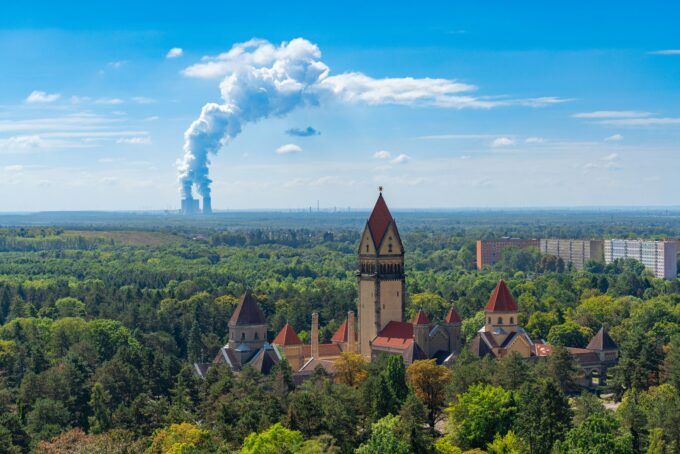Nuclear Resisters in German Prisons
August 7, 2024

Image by Timo Volz.
A pair of front-line nuclear weapon abolitionists are incarcerated in a German prison camp this week, while hundreds of activists and reporters like me just write about the anniversaries of the atomic fire-bombings of Hiroshima and Nagasaki by the United States government.
Susan Crane of Redwood City, Calif., and Susan van der Hidjen of Amsterdam, are doing time over unpaid fines for criminal trespass convictions after they dared to use their bodies as symbols of their highest hopes. Along with dozens of others, they entered Germany’s nuclear weapons base at Büchel without permission, in order to interrupt and demand an end to the threatened use of U.S. nuclear weapons stationed there. (German pilots routinely train to fly the 50-to-170-kiloton U.S. “B61” hydrogen bombs to Russia, and to detonate them there — each one incinerating up to 11 times more than the 15-kiloton Hiroshima bomb.)
Beginning June 4, the two women spent over seven weeks in the locked-down women’s prison at Rohrbach where they were kept in their cell 23 hours a day. On July 29, they were moved to a minimum-security “open prison” at Koblenz, where they’re allowed more movement, mail, phone calls, and contact with other prisoners. Crane is serving 229 days, Van der Hijden 115, and they are the first two women from outside Germany to be jailed there for nuclear weapons protests. Crane’s other first is that she is serving the longest prison sentence ever imposed in the 25-year-long nonviolent campaign to oust the U.S. hydrogen bombs from Germany. She isn’t due out until December.
Friends and foes often ask, How does a prison sentence help condemn nuclear weapons threats? A short answer might be: Jail-going removes the resister’s cooperation with this state-sponsored terrorism; it dramatizes the seriousness and urgency of nuclear weapons threats; it forces courts, prosecutors, and military personnel to endorse and protect nuclear attack plans and weapons; and it can create a crisis of conscience among community members, police forces, and judicial officers who must decide whether to keep collaborating with nuclear terror.
Merely taking a political trespass case to trial, as Crane and Van der Hijden did, is often called wearisome and futile, since not-guilty verdicts are so rare. Yet public trials in nuclear weapons protest cases can shine a bright light: first, on war plans that most people pay for but don’t want to think about, and, second, on the court’s double standard in which judges demand strict obedience of the letter of trespass statutes, while excusing, ignoring, or joining the government’s open violations of international law. (The Nonproliferation Treaty prohibits any transfer of nuclear weapons between states parties. Both the U.S. and Germany are parties.)
Crane and Van der Hijden have worked for years in their respective cities providing aide and support for poor and homeless people. The poverty they see every day has moved both of them to a radical pacifism that ‘overturns the tables of the money changers in the temple’, or, in their case, interrupts nuclear war planners who polish, house, fuel weapons systems that can only produce massacres like Hiroshima and Nagasaki. The two wrote from the prison July 30, “We gratefully accept the offer from the German justice system to give us a few months of food and lodging while allowing us to work with the people who suffer the most from money going towards war preparations instead of education, health care, or social housing.”
An earlier observer said, “Nuclear weapons kill without being used by forcing people to starve.” But nuclear weapons are used — every day — in the military’s ongoing and “credible” bomb threats known as “deterrence.” The so-called “tactical” nuclear bombs at the German base have between 3 and 11 times more explosive power than the Hiroshima bomb that killed 140,000 people. The B61 bombs are often called “smaller” than “strategic” nuclear weapons “which are city busters.” This description — used by major news services — is preposterous because it ignores the fact that much smaller atomic explosives (15 and 20 kilotons) caused the city-busting obliteration of Hiroshima and Nagasaki.
Even these “smallest” of warheads in the U.S. arsenal are city busters. Crane and Van der Hijden are learning the hard way that nuclear weapon protectors at court don’t bother about busting civilians either.
No comments:
Post a Comment